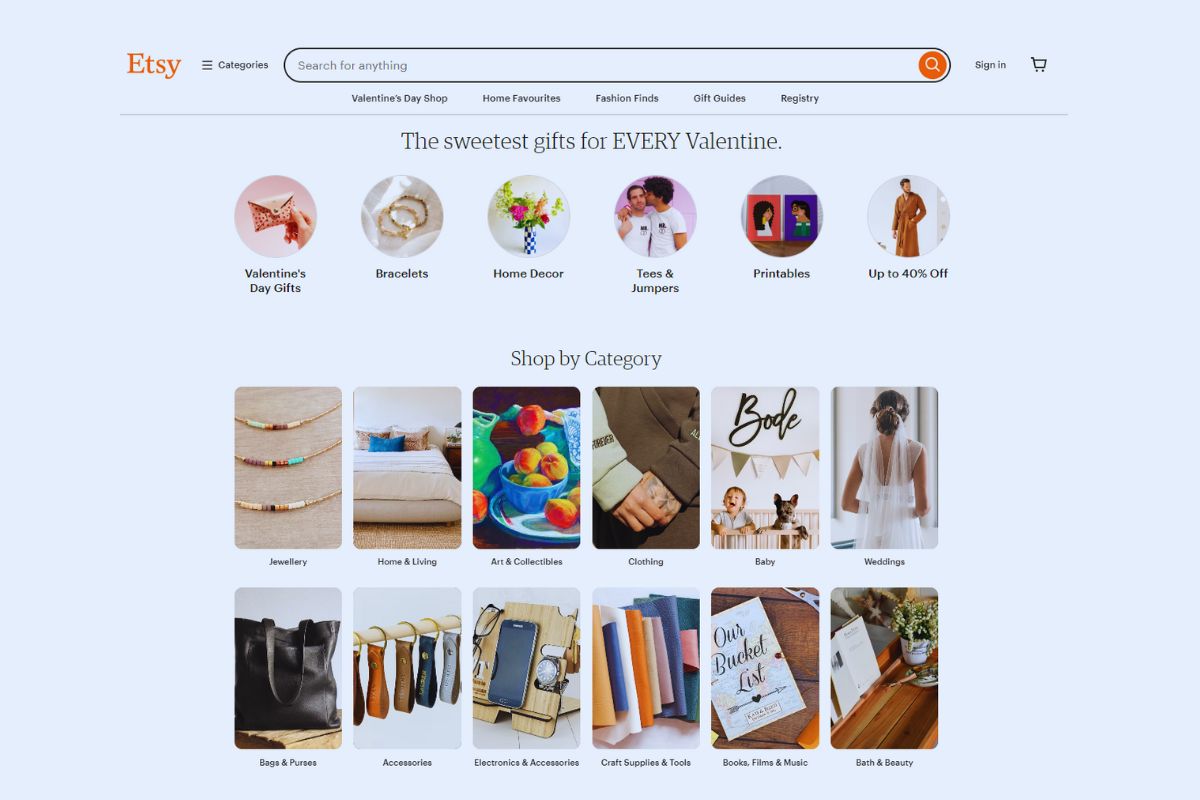Etsy is a popular platform for creative sellers, but many wonder if dropshipping is allowed.
Etsy does permit dropshipping, but with specific rules you must follow. You need to be the designer or maker of the products you sell, and if you work with production partners, you must disclose this in your product listings.
Table of contents
- Understanding Dropshipping on Etsy
- Setting up a Dropshipping Business on Etsy
- Operational Aspects of Etsy Dropshipping
- Marketing Your Dropshipping Products
- Financial Considerations in Dropshipping
- Challenges and Solutions in Etsy Dropshipping
- Advanced Strategies for Successful Etsy Dropshipping
- Frequently Asked Questions
- How can one conduct dropshipping on Etsy without violating their policies?
- What are the profitability prospects of dropshipping on Etsy?
- What types of products are permissible for dropshipping on Etsy?
- Can sellers use Etsy as a source for dropshipping to Shopify stores?
- What are the requirements for identifying legitimate dropshipping suppliers on Etsy?
- What changes have been made to Etsy’s dropshipping policy in recent years?
Understanding these guidelines is crucial for anyone looking to set up an Etsy shop.
While you can partner with manufacturers to streamline your process, avoid simply reselling items from other websites. This means you should focus on unique products that reflect your creative vision while adhering to Etsy’s policies.
Getting familiar with what’s allowed can help you make informed decisions and run a successful dropshipping business on Etsy. By following the rules, you can tap into a broad market while maintaining the platform’s integrity.
Understanding Dropshipping on Etsy
Dropshipping on Etsy involves selling items without holding any inventory. It’s essential to know how Etsy’s rules apply to this business model and the differences between dropshipping and reselling on the platform.
Definition of Dropshipping
Dropshipping is a retail fulfillment method where the seller doesn’t keep products in stock.
Instead, when you sell an item, you purchase the item from a third party who then ships it directly to the customer. This model allows you to offer a wide range of products without the need for upfront investment in inventory. On platforms like Etsy, this means you can create a storefront that showcases products without handling the physical items.
For Etsy sellers, it’s crucial to identify if the items you plan to sell are aligned with Etsy’s focus on handmade goods and vintage items. This focus makes it different from typical dropshipping platforms where any type of product can be sold.
Etsy’s Policy on Dropshipping
Etsy has clear policies regarding dropshipping. According to Etsy’s guidelines, you must be the designer of the products you sell. You can collaborate with production partners for manufacturing, but it’s vital to disclose this information in your listings. This means that you can outsource the production but must still claim the design as your own.
Failure to comply with Etsy’s rules may lead to penalties, including suspension of your shop. Understanding these guidelines is key to ensuring your dropshipping business operates without issues. Always check the latest updates on Etsy’s Seller Policy Page to stay informed about any changes.
Reselling vs. Dropshipping
Reselling involves purchasing products from another seller and then selling them to customers, often without making any modifications. This differs from dropshipping as you don’t create or design the product.
On Etsy, reselling is typically not allowed for items that do not meet the platform’s handmade or vintage criteria.
If you aim to dropship, you must focus on products that can be identified as crafted or designed by you. You might consider items such as craft supplies that allow for some creativity, ensuring they fit Etsy’s unique marketplace.
Understanding the distinction between reselling and dropshipping is crucial for a successful Etsy store, particularly if you want to maintain compliance with Etsy’s guidelines.
Setting up a Dropshipping Business on Etsy
| Aspect | Details |
|---|---|
| Does Etsy Allow Dropshipping? | Yes, but with restrictions. You must comply with Etsy’s Handmade Policy, meaning you cannot resell items made by third parties unless they qualify under Etsy’s allowed practices. |
| Allowed Dropshipping Methods | – Print-on-Demand (POD): Using platforms like Printify or Printful, where products are made-to-order with your designs. – Partnering with Small-Scale Manufacturers: You must disclose their details in your shop. |
| Not Allowed Dropshipping | – Reselling from AliExpress, Amazon, or Wholesale Suppliers – Mass-Produced Items Without Personalization |
| How to Do Dropshipping on Etsy? | 1. Create Custom Designs for Print-on-Demand items (T-shirts, mugs, posters, etc.). 2. Partner with POD Suppliers like Printify, Printful, or Gooten. 3. List Products as Your Own – Ensure your shop and listings comply with Etsy’s Handmade policy. 4. Be Transparent – Mention production partners in your shop settings. 5. Handle Customer Service – You’re responsible for customer support and order issues. |
| Best Platforms for Etsy-Compatible Dropshipping | – Printify (Wide product range, global fulfillment) – Printful (Fast shipping, high-quality prints) – Gooten (More product customization options) |
| Potential Risks & Challenges | – Strict Etsy Policies: Etsy frequently reviews shops for policy violations. – Shipping & Delivery Delays: Customers expect fast delivery, so choose a reliable fulfillment partner. – Competition: Many sellers use Print-on-Demand, so standing out with unique designs is crucial. |
Starting a dropshipping business on Etsy involves several key steps. You need to create an Etsy shop, find reliable suppliers, integrate production partners, and list your products effectively. Each of these steps is crucial for your business’s success.
Creating an Etsy Shop for Dropshipping
To begin, visit Etsy’s homepage and register for an account. Click on “Open your Etsy shop” and follow the prompts.
You’ll need to provide your shop name, which should reflect your brand and offerings.
Once set up, customize your shop with a profile picture and shop banner to create a professional look. Make sure to fill out the “About” section to engage potential customers. Clear policies on shipping and returns will help manage buyer expectations.
Consider linking your Etsy shop to a Shopify store if you plan to expand your online presence. This can streamline the management of orders and inventory across platforms.
Finding the Right Dropshipping Suppliers
Choosing the right dropshipping suppliers is essential. Look for suppliers that offer quality products and reliable shipping services.
You can find platforms like Printful that specialize in print-on-demand products. This approach allows you to sell custom items without holding inventory.
Research suppliers based on their reputation, product range, and customer reviews. Ensure they can handle the volume of orders you expect. Some suppliers will handle everything from printing to shipping, which can save you time.
It’s helpful to order samples from potential suppliers. This gives you a firsthand look at the product quality and shipping speed.
Integrating Production Partners
Integration with production partners is vital for smooth operations. Many suppliers, such as Printful or Printify, can connect directly with your Etsy shop. This automation helps you manage orders efficiently.
Once you choose a production partner, follow their setup guidelines. Typically, you will need to create an account with them and link it to your Etsy shop. This process often involves using API keys or integration tools.
Keep communication channels open with your suppliers. Make sure they understand your needs for quality, packaging, and delivery timelines. This relationship is important for maintaining a good customer experience.
Listing Your Dropshipping Products
Creating effective Etsy listings will attract customers. Start by writing clear and detailed product descriptions. Highlight the unique aspects of your items, especially if they are custom or made-on-demand.
Use high-quality images, as they can significantly impact sales. Consider including multiple angles and lifestyle shots to showcase your products.
Set competitive prices by considering the cost of goods, shipping, and Etsy fees. Additionally, use relevant keywords in your titles and descriptions to improve your shop’s visibility in search results. Regularly update your listings to keep them fresh and engaging for potential buyers.
Operational Aspects of Etsy Dropshipping
Dropshipping on Etsy requires careful attention to inventory management, customer service, and fulfillment processes. You need a clear plan to ensure smooth operations throughout the selling process.
Managing Inventory and Orders
Managing inventory is crucial in a dropshipping business. Since you don’t hold physical stock, keeping track of your supplier’s inventory is essential.
Use software tools to monitor stock levels and receive alerts when items are low.
Set up clear order management processes to fulfill customer purchases. This may involve integrating your Etsy shop with your supplier’s system for real-time updates.
Create a checklist for order verification to minimize errors, ensuring that each order is processed accurately.
Utilize a spreadsheet to track orders, including the item ordered, payment status, and shipping updates. This will help you stay organized and respond quickly to customer inquiries.
Ensuring Quality Customer Service
Providing excellent customer service is key to building a good reputation on Etsy.
Respond to customer questions promptly to show you value their concerns. Aim to reply within 24 hours to maintain a positive relationship.
Since you rely on suppliers for product quality, establish a good communication line with them. Discuss your expectations for quality and delivery timelines. If issues arise, be proactive in addressing them with your customers.
Create a FAQ section in your shop to help customers find answers quickly. This can reduce the number of inquiries you receive and streamline communication.
Fulfillment and Shipping Considerations
Shipping times are an important factor in customer satisfaction. Ensure you have clear policies about processing and shipping times. Communicate these details in your product listings.
Work with suppliers who can provide reliable shipping options. Research their shipping times and methods to ensure they align with your customer expectations.
Use tracking information to keep customers updated on their orders. Send a confirmation email once an order ships, including tracking details. This transparency fosters trust and encourages repeat purchases.
Marketing Your Dropshipping Products
| Marketing Strategy | How to Implement |
|---|---|
| SEO Optimization | Use relevant keywords in product titles, descriptions, and tags. Optimize Etsy listings with high-quality images and compelling descriptions. |
| Social Media Marketing | Promote your products on Instagram, Facebook, Pinterest, and TikTok. Use trending hashtags, influencer collaborations, and engaging posts. |
| Facebook & Instagram Ads | Run targeted ads to reach potential buyers. Retarget visitors who viewed your products but didn’t purchase. |
| Content Marketing (Blogging & Videos) | Create blogs or YouTube videos about your niche. Offer value through styling guides, gift ideas, or product comparisons. |
| Email Marketing & Newsletters | Build an email list and send promotions, discounts, and product recommendations to drive sales. |
| Influencer & Affiliate Marketing | Partner with micro-influencers in your niche. Offer affiliate commissions for referrals. |
| Pinterest Marketing | Create engaging Pinterest boards and pins showcasing your products with lifestyle images. |
| TikTok & Reels Marketing | Create viral product showcase videos using trends, ASMR, or “unboxing” content. |
| Customer Reviews & UGC (User-Generated Content) | Encourage buyers to leave reviews and share photos/videos of their purchases. Use testimonials in your marketing. |
| Limited-Time Offers & Discounts | Run flash sales, bundle deals, or first-time buyer discounts to encourage immediate purchases. |
| Cross-Selling & Upselling | Recommend related products in your Etsy listings and emails. Offer bundle discounts for higher order value. |
Marketing your dropshipping products is essential for success on Etsy. Focus on optimizing your product listings, leveraging social media, and building an email list to reach more customers.
Optimizing Product Listings for SEO
To attract buyers on Etsy, optimizing your product listings for search engines is crucial. Use relevant keywords in your titles and descriptions. Think about what customers might type when searching for your unique items.
Key Elements to Include:
- Title: Make it clear and include keywords.
- Description: Write a detailed description that helps buyers understand the product.
- Tags: Use all available tags to cover various search terms.
- Images: High-quality images can capture attention and improve click-through rates.
Regularly review and update your listings to keep them fresh and relevant.
Using Social Media to Increase Sales
Social media is a powerful tool to promote your Etsy storefront. Platforms like Instagram, Facebook, and Pinterest can help showcase your unique items.
Tips for Effective Social Media Marketing:
- Post Regularly: Share new items, behind-the-scenes content, and customer testimonials.
- Engage with Followers: Respond to comments and messages to build a community around your brand.
- Collaborate with Influencers: Partnering with influencers can expose your products to a broader audience.
- Run Targeted Ads: Use social media ads to reach specific demographics interested in your niche.
By consistently sharing content, you build brand awareness and drive traffic to your Etsy shop.
Building an Email List for Your Store
Email marketing allows you to maintain direct contact with potential customers. Start by creating a sign-up form on your Etsy page or website.
Benefits of Building an Email List:
- Promotional Offers: Send exclusive discounts to subscribers to encourage purchases.
- New Product Announcements: Inform your audience about new designs or restocks.
- Customer Feedback: Ask for reviews and suggestions to improve your products.
Tips for Success:
- Create Valuable Content: Offer useful tips or insights related to your niche.
- Segment Your Audience: Tailor your emails based on customer preferences for higher engagement rates.
- Monitor Results: Track open rates and click-through rates to optimize future campaigns.
An active email list can lead to higher sales and create loyal customers.
Financial Considerations in Dropshipping

When starting a dropshipping business on Etsy, understanding the financial aspects is crucial for success. You need to be aware of listing fees, transaction costs, and strategies to optimize your expenses while reaching a wider audience.
Understanding Etsy’s Listing and Transaction Fees
Etsy has specific fees that you need to consider. Each listing costs $0.20 and lasts for four months or until the item sells. When an item sells, Etsy charges a 5% transaction fee based on the sale price. Additionally, there’s a 3% + $0.25 payment processing fee for each sale.
Make sure to account for these costs to price your products effectively.
For example, if you sell an item for $20, you will pay $1.20 in fees. This will help you set prices that cover all associated costs while keeping your profits sustainable.
Cost-Effective Strategies for Dropshippers
To reduce expenses, consider using cost-effective strategies.
First, choose suppliers that offer bulk discounts or lower shipping rates. This can lead to a better profit margin.
Second, focus on marketing your products using social media. Organic reach can save you money on paid ads. Use email marketing to engage with past customers, which is typically less costly than acquiring new customers.
Lastly, take advantage of Etsy’s tools. Use SEO to improve your visibility. Good keywords can help you attract more buyers without incurring additional costs.
Targeting a Global Customer Base
Expanding into the international market can significantly increase your sales.
When dropshipping, choose suppliers who can ship worldwide easily and affordably.
Consider the costs associated with international shipping. This can affect your pricing strategy. Be transparent about shipping costs to avoid surprises for customers.
Additionally, research the customs regulations of your target countries. These can impact delivery times and costs. By properly targeting a global audience, you can expand your reach and grow your dropshipping business effectively.
Challenges and Solutions in Etsy Dropshipping

Starting an Etsy dropshipping business comes with specific challenges. Understanding these can help you find effective solutions.
The unique market, fees, and product visibility are crucial to your success.
Overcoming the Unique Challenges of Etsy
Etsy has a specific market focused on handmade and unique items. This can be a challenge for dropshippers who rely on mass-produced goods.
To stand out, you must position your products as unique and ensure they align with Etsy’s values.
Consider sourcing from production partners who create original items. This maintains Etsy’s focus on craftsmanship while allowing you to dropship.
Be transparent about your partnerships in your listings. Keeping communication open with your production partners is vital to manage quality and order fulfillment effectively.
Strategic Product Research and Market Analysis
Before you start, conduct thorough product research. Identify trending items using tools like Etsy Rank or Google Trends.
Knowing what sells helps you make informed decisions.
Consider creating a list of potential product categories. Analyze their performance on Etsy. Look for gaps in the market that you can fill.
Pay attention to customer reviews and feedback for existing products. This will guide you in designing or selecting items that meet customer needs.
Keep in mind that high listing fees can impact your profitability. Factor these costs into your pricing strategy to maintain margins while remaining competitive.
Scaling Your Etsy Dropshipping Business
As you grow, finding ways to scale is essential. Focus on increasing your product range while maintaining quality.
You can add complementary items to your store or explore seasonal trends.
Utilize social media to boost visibility. Platforms like Instagram and Pinterest can drive traffic to your Etsy shop.
Engaging content can attract potential customers and encourage shares.
Evaluate your fulfillment process regularly. As your sales increase, ensure your production partners can keep up.
A reliable supply chain is crucial to avoid delays and maintain customer satisfaction.
Advanced Strategies for Successful Etsy Dropshipping
| Strategy | How to Implement |
|---|---|
| Niche Selection & Brand Differentiation | Focus on a unique, high-demand niche with low competition. Create a brand identity with a distinct style, logo, and packaging. |
| Premium Product Descriptions | Write compelling, SEO-optimized product descriptions highlighting product benefits, materials, and usage. Use storytelling to enhance engagement. |
| High-Quality Visuals | Use professional mockups, lifestyle images, and videos to showcase your products. Utilize Printify or Placeit for premium mockups. |
| Automate Order Fulfillment | Integrate tools like Printify, Printful, or Spocket to streamline order processing and reduce manual work. |
| Etsy Ads & PPC Campaigns | Invest in Etsy Ads to boost visibility. Set daily budgets and optimize based on conversion data. |
| Leverage AI & Chatbots | Use AI-powered customer support tools like ChatGPT-based chatbots for instant query handling and upselling. |
| Personalization & Custom Orders | Offer customization options like engraved messages, name prints, or color variations to increase perceived value. |
| Multi-Platform Selling | Expand to Shopify, Amazon, or eBay while syncing inventory with Etsy. Use apps like Sellbrite or CedCommerce. |
| Conversion Rate Optimization (CRO) | Optimize your Etsy storefront with compelling banners, trust badges, and easy navigation. A/B test different product images and descriptions. |
| Loyalty & Referral Programs | Implement loyalty programs with discounts for repeat buyers. Offer referral rewards to encourage word-of-mouth marketing. |
| Influencer & UGC Marketing | Partner with micro-influencers or TikTok creators for product promotions. Encourage buyers to share user-generated content (UGC). |
| Social Proof & Trust Building | Feature verified buyer reviews prominently. Display “best-selling” and “fast shipping” tags on popular products. |
| Dynamic Pricing Strategy | Adjust pricing based on demand, seasonality, and competitor analysis. Use pricing tools like EverBee or Alura. |
| Email Marketing & Retargeting | Build an email list for exclusive offers. Use Facebook Pixel & Google Ads retargeting to re-engage potential buyers. |
| Wholesale & Bulk Orders | Offer discounts for bulk purchases to attract wholesale buyers and repeat customers. |
To succeed in Etsy dropshipping, you should consider specific strategies that focus on unique products and the needs of your customer base.
Using print-on-demand, curating custom items, and diversifying your offerings can set you apart from the competition.
Leveraging Print-on-Demand Products
Print-on-demand (POD) products let you offer customized items without holding inventory. You can create unique designs for apparel, mugs, or wall art.
Use tools like Printful or Printify to connect your Etsy shop with POD suppliers.
When choosing designs, focus on what resonates with your target audience. Trending themes like zodiac signs or personalized gifts often attract buyers.
Make sure you optimize product listings with clear titles, descriptions, and tags to enhance search visibility.
POD reduces upfront costs and lets you experiment with different designs. Once you find what sells well, you can scale your offerings more efficiently.
Curating a Selection of Unique and Custom Products
Curating unique and custom products can help you stand out in a crowded marketplace. Look for items that fulfill niche interests or that appeal to specific customer bases, like craft supply items or personalized gifts.
Invest time in finding reliable suppliers who offer these custom options. You might work with local artisans or small businesses.
Highlight the story behind each product, as this can create an emotional connection with buyers.
When listing your products, focus on high-quality images and detailed descriptions. Customers are more likely to purchase when they understand the value and uniqueness of what they’re buying.
Diversifying Beyond Physical Products
Expanding your offerings beyond physical products can be a smart strategy. Digital products such as e-books, printables, or templates require no inventory. They can also have high-profit margins since production costs are low.
Consider what skills or expertise you have that could be turned into a digital product. E-commerce platforms often favor sellers who provide diverse options, as this can attract a wider audience.
Additionally, you can offer instructional videos or workshops related to crafting or DIY projects. This not only enhances your product range but also helps build a loyal customer base that trusts your expertise.
Frequently Asked Questions
Understanding the rules and practices surrounding dropshipping on Etsy is essential. Here are key questions that can guide you through the process.
How can one conduct dropshipping on Etsy without violating their policies?
To dropship on Etsy legally, you need to create your own unique products. Ensure you are involved in the design process.
Avoid reselling mass-produced items without adding personal touch or value, as this can lead to bans.
What are the profitability prospects of dropshipping on Etsy?
Profitability can vary based on your niche and product quality. By focusing on unique, handmade, or personalized items, you can attract more customers.
Researching market trends will also help you identify what sells well.
What types of products are permissible for dropshipping on Etsy?
Permissible products include those that you design or have a significant personal touch. Items like print-on-demand goods often fit Etsy’s guidelines.
Avoid reselling generic items from other platforms like AliExpress or Amazon that lack customization.
Can sellers use Etsy as a source for dropshipping to Shopify stores?
Using Etsy as a source for dropshipping to Shopify is not allowed. Etsy’s policies prohibit reselling items from its platform.
If you want to sell on Shopify, you need to source products specifically for that platform, adhering to its rules.
What are the requirements for identifying legitimate dropshipping suppliers on Etsy?
Look for suppliers that allow customization and personal involvement in the products. Research reviews and ensure they provide quality items.
Check that they can handle shipping and customer service efficiently to maintain your shop’s reputation.
What changes have been made to Etsy’s dropshipping policy in recent years?
Etsy has clarified its stance on dropshipping. In recent years, they have tightened rules to ensure sellers add value and uniqueness to their listings.
They emphasize handmade and personalized products, making it necessary for dropshippers to adapt their strategies accordingly.



